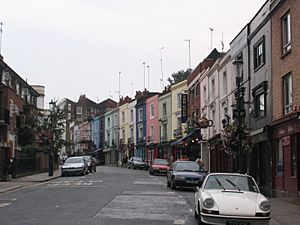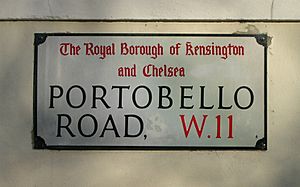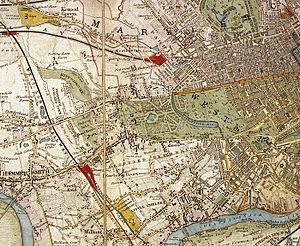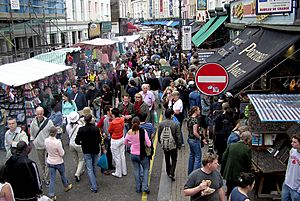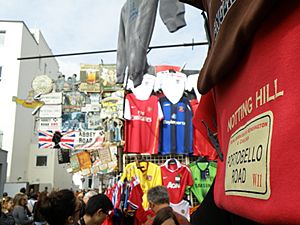Portobello Road facts for kids
Portobello Road is a famous street in the Notting Hill area of west London, England. It stretches almost the entire length of Notting Hill, running from south to north. On Saturdays, Portobello Road becomes home to one of London's most well-known street markets. This market is famous for its second-hand clothes, delicious pastries, and antiques.
Every August since 1996, the Portobello Film Festival takes place in different spots around Portobello Road. Also, in 2015, Portobello Radio started as a local radio station for the community.
Contents
History of Portobello Road
How Portobello Road Began
Before 1740, Portobello Road was just a winding country path called Green's Lane. It led from an area known as Kensington Gravel Pits (now Notting Hill Gate) up to Kensal Green in the north.
The 1700s
In 1740, a farm called Portobello Farm was built near what is now Golborne Road. The farm got its name from a big victory during a war. Admiral Edward Vernon captured a Spanish-ruled town called Puerto Bello (now Portobelo in Panama). This battle was part of the War of Jenkins' Ear. Today, a street called Vernon Yard, which is off Portobello Road, still honors the Admiral's name. The land where Portobello Farm once stood is now home to St Charles' Hospital.
The 1800s
Portobello Farm was sold to a group of nuns after railways arrived in 1864. These nuns, from the Dominican Order, built St Joseph's Convent there.
Portobello Road as we know it today was mostly built during the Victorian era. Before about 1850, it was mainly a country lane connecting Portobello Farm to Kensal Green and Notting Hill. Much of the area was open land with fields and orchards. The road slowly grew in the second half of the 1800s, fitting between new housing areas like Paddington and Notting Hill.
The shops and markets on Portobello Road served the rich people living in the fancy houses nearby. Working-class people in the area found jobs as builders, house servants, drivers, messengers, and street sellers. After the Hammersmith and City Railway was finished in 1864, and Ladbroke Grove station opened, the northern part of Portobello Road also developed. Soon, all the open fields were covered with buildings.
Portobello Road Today
Portobello Road is home to many different communities. Its buildings are unique, with winding roads and curving streets. This is different from the more planned streets nearby. Most buildings are Victorian-era houses and shops, built close together.
A group called "Friends of Portobello" works to keep the street's special feel. They try to stop big chain stores from taking over, so that local, independent shops can thrive. Portobello Road is also home to the Electric Cinema. This is one of Britain's oldest cinemas and is a protected historic building.
Geography of the Road
Portobello Road goes up and down. At its highest point in the north, it's about 84 feet (25.6 meters) above sea level. It then drops to its lowest point of 65 feet (19.8 meters) near the overpasses. After that, the road rises and falls again, reaching about 78 feet (23.8 meters) at its southern end.
Portobello Road Market
The Portobello Road Market attracts thousands of visitors every year. The best day to find antiques is Saturday. On this day, all five parts of the market are open:
- Second-hand goods
- Clothes and fashion
- Things for the house
- Fruits, vegetables, and other food
- Antiques
However, you can find stalls selling clothes, antiques, and fresh food throughout the week. These are located further north, closer to the Westway Flyover. The shops and cafes along the road are open daily.
The market started like many other London markets, mainly selling fresh food in the 1800s. Dealers selling antiques and other goods began to arrive in the late 1940s and 1950s. Over time, antiques became the main reason people visit this market, especially on Saturday mornings. It is now the largest antiques market in the UK.
The market section of Portobello Road is about 1,028 yards (940 meters) long. It runs from Golborne Road in the north to Westbourne Grove in the south. About a third of the way from its north end, the market goes under bridges for the A40 road and the Hammersmith & City line of the London Underground. Here, the market often focuses on second-hand clothes and designer fashion.
Portobello Road in Movies, Books, and Music
Movies
- The market was a key location for the 1999 movie Notting Hill. Much of the filming happened right on the street.
- The 1950 police movie The Blue Lamp also filmed scenes in the Portobello area. It shows what the area looked like before the Westway highway was built.
- The 1971 musical film Bedknobs and Broomsticks has a scene with a song called "Portobello Road." The song's words talk about the market and the people who live and work there.
- In 2006, a short film called Portobello: Attack of the Clones won awards. It showed how big chain stores were changing the unique, independent feel of Portobello Road.
Theatre
- The 1959 British musical Make Me an Offer takes place on Portobello Road. It includes a song also called "Portobello Road."
Books
- Portobello Road is mentioned in Martin Amis's 1989 book London Fields.
- In the short story "The Portobello Road" by Muriel Spark, a murderer keeps going to the market because he is visited by the ghost of his victim.
- The famous British children's character Paddington Bear loves visiting Portobello Market every day. His friend Mr. Gruber, who owns an antique shop on Portobello Road, is where Paddington often has his afternoon tea.
- In 2008, Ruth Rendell wrote a book called Portobello, which is set in the area.
- It is also the setting for Paulo Coelho's 2007 book, The Witch of Portobello.
- The market is mentioned in the 1970 book The Chinese Agent by Michael Moorcock.
- In the short story "Different Skies" by China Miéville, the main character buys a strange window pane at Portobello Road Market.
Music
- In 1978, the rock band Dire Straits sang about the road in their song "Portobello Belle" on their album Communiqué.
- Michael Flanders of Flanders & Swann mentions a special glass bottle from "the Portobello Road" in his song "Have Some Madeira M'Dear."
- Donovan's song "Sunny South Kensington" includes the words: "...in the Portobella I met a fella with a cane umbrella."
- The 1966 song "Portobello Road" by Cat Stevens is about walking through the famous street and market.
- The band Blur mentions Portobello Road in their 1993 song "Blue Jeans."
- In 1972, Caetano Veloso sang "walk down Portobello Road to the sound of reggae" in his song "Nine Out Of Ten."
TV Shows
- In the TV show Only Fools and Horses, the idea for an episode came to the writer, John Sullivan, after he visited Portobello Road.
- The street and its name also appeared often in the TV series Minder.
- The TV show Bargain Hunt often features people buying items at the market to sell later at an auction.
- A popular Italian TV show from 1977 to 1983 was named Portobello after Portobello Road.
See also
 In Spanish: Portobello Road para niños
In Spanish: Portobello Road para niños


